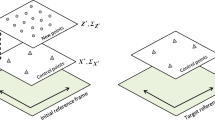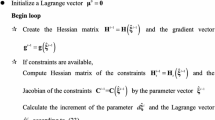Abstract
Although centralized coordinates are applied in geodetic coordinate transformations implicitly or explicitly, the centering strategy has not been comprehensively investigated from the theoretical perspective. In this contribution, we replace the existing universal transformation model with a more compact formulation, where the singular cofactor matrix caused by the model structure is successfully evaded. Furthermore, the developed partition representation of the solution that avoids the numerical difficulty of the non-partition model is more general than any previous partition representation. According to the empirical pre-processing, we further establish two models: the shifting model and the translation elimination model. The former allowing arbitrary shifts in the coordinates of the same kind presents the translational invariance, i.e., the shift can be independent of the original coordinates and the structure of the stochastic model, whereas the latter removes the translation parameters in the pre-adjustment phase by the partial orthogonality of the coefficient matrices, which centralizes the coordinates and changes the stochastic model simultaneously. Test computations with different weight structures show the validity of these strategies.
Similar content being viewed by others
Data availability
All data analyzed during this study are included in this published article.
References
Amiri-Simkooei A (2018) Parameter estimation in 3D affine and similarity transformation: implementation of variance component estimation. J Geodesy 92(11):1285–1297
Aydin C, Mercan H, Uygur SÖ (2018) Increasing numerical efficiency of iterative solution for total least-squares in datum transformations. Stud Geophys Geod 62(2):223–242
Blewitt G (1998) GPS data processing methodology: from theory to applications. In: GPS for Geodesy, Springer, pp 231–270
Borg I, Groenen PJ (1997) Modern multidimensional scaling: theory and applications. Springer Science & Business Media, New York
Bursa M (1962) The theory for the determination of the non-parallelism of the minor axis of the reference ellipsoid and the inertial polar axis of the earth, and the planes of the initial astronomic and geodetic meridians from the observation of artificial earth satellites. Stud Geophys Geod 6:209–214
Chang G (2015) On least-squares solution to 3D similarity transformation problem under Gauss-Helmert model. J Geodesy 89(6):573–576
Chang G (2016) Closed form least-squares solution to 3D symmetric Helmert transformation with rotational invariant covariance structure. Acta Geod Geoph 51(2):237–244
Chang G, Xu T, Wang Q (2017a) Error analysis of the 3D similarity coordinate transformation. GPS Solutions 21(3):963–971
Chang G, Xu T, Wang Q, Liu M (2017b) Analytical solution to and error analysis of the quaternion based similarity transformation considering measurement errors in both frames. Measurement 110:1–10
Chatzinikos M, Dermanis A (2017) A coordinate-invariant model for deforming geodetic networks: understanding rank deficiencies, non-estimability of parameters, and the effect of the choice of minimal constraints. J Geodesy 91(4):375–396
Dermanis A, Grafarend EW (1981) Estimability analysis of geodetic, astrometric and geodynamical quantities in very long baseline interferometry. Geophys J Int 64(1):31–56
Fang X (2011) Weighted total least squares solutions for applications in geodesy. Gottfried Wilhelm Leibniz Universität Hannover, Hannover, Germany, Hannover
Fang X (2013) Weighted total least squares: necessary and sufficient conditions, fixed and random parameters. J Geodesy 87(8):733–749
Fang X (2014a) A structured and constrained total least-squares solution with cross-covariances. Stud Geophys Geod 58(1):1–16
Fang X (2014b) A total least squares solution for geodetic datum transformations. Acta Geod Geophy 49(2):189–207
Fang X (2015) Weighted total least-squares with constraints: a universal formula for geodetic symmetrical transformations. J Geodesy 89(5):459–469
Felus YA, Burtch RC (2009) On symmetrical three-dimensional datum conversion. GPS Solutions 13(1):65–74
Golub GH, Pereyra V (1973) The differentiation of pseudo-inverses and nonlinear least squares problems whose variables separate. SIAM J Numer Anal 10(2):413–432
Golub GH, Pereyra V (2003) Separable nonlinear least squares: the variable projection method and its applications. Inverse Prob 19(2):R1–R26
Grafarend EW, Awange JL (2003) Nonlinear analysis of the three-dimensional datum transformation. J Geodesy 77(1–2):66–76
Horn BK (1987) Closed-form solution of absolute orientation using unit quaternions. J Opt Soc A 4(4):629–642
Kanatani K (2020) 3D rotations: parameter computation and lie algebra-based optimization. Chapman and Hall/CRC, Boca Raton, Fla
Koch KR (1986) Maximum likelihood estimate of variance components. Bulletin Géodésique 60(4):329–338
Kotsakis C (2013) Generalized inner constraints for geodetic network densification problems. J Geodesy 87(7):661–673
Kotsakis C, Vatalis A, Sanso F (2014) On the importance of intra-frame and inter-frame covariances in frame transformation theory. J Geodesy 88(12):1187–1201
Leick A, Rapoport L, Tatarnikov D (2015) GPS satellite surveying. John Wiley & Sons, Hoboken, New Jersey
Leick A, van Gelder BHW (1975) On similarity transformations and geodetic network distortions based on Doppler satellite observations. Rep. No. 235, Department of Geodetic Science, Ohio State University, Columbus, Ohio
Li B, Shen Y, Li W (2012) The seamless model for three-dimensional datum transformation. Sci China Earth Sci 55(12):2099–2108
Li B, Shen Y, Zhang X, Li C, Lou L (2013) Seamless multivariate affine error-in-variables transformation and its application to map rectification. Int J Geogr Inf Sci 27(8):1572–1592
Mahboub V (2012) On weighted total least-squares for geodetic transformations. J Geodesy 86(5):359–367
Mercan H, Akyilmaz O, Aydin C (2018) Solution of the weighted symmetric similarity transformations based on quaternions. J Geodesy 92(10):1113–1130
Neitzel F (2010) Generalization of total least-squares on example of unweighted and weighted 2D similarity transformation. J Geodesy 84(12):751–762
Pearson C, Snay R (2013) Introducing HTDP 3.1 to transform coordinates across time and spatial reference frames. GPS Solutions 17(1):1–15
Qin Y, Fang X, Zeng W, Wang B (2020) General total least squares theory for geodetic coordinate transformations. Appl Sci 10(7):2598
Schaffrin B, Felus YA (2008) On the multivariate total least-squares approach to empirical coordinate transformations. Three algorithms. Journal of Geodesy 82(6):373–383
Schaffrin B, Wieser A (2008) On weighted total least-squares adjustment for linear regression. J Geodesy 82(7):415–421
Schaffrin B, Snow K, Neitzel F (2014) On the errors-in-variables model with singular dispersion matrices. J Geodetic Sci 4(1):28–36
Shen Y, Chen Y, Zheng D (2006) A quaternion-based geodetic datum transformation algorithm. J Geodesy 80(5):233–239
Snow K (2012) Topics in total least-squares adjustment within the errors-in-variables model: singular cofactor matrices and prior information. PhD thesis, The Ohio State University
Soler T, Han JY (2017) On rotation of frames and physical vectors: an exercise based on plate tectonics theory. GPS Solutions 21(2):345–361
Teunissen PJG (1988) The non-linear 2D symmetric Helmert transformation: an exact non-linear least-squares solution. Bulletin Géodésique 62(1):1–16
Teunissen PJG (2000) Adjustment theory: an introduction, series on mathematical geodesy and positioning. Delft University Press, Netherlands
Teunissen PJG (1985) The geometry of geodetic inverse linear mapping and non-linear adjustment, Publications on Geodesy, vol 8. Netherlands Geodetic Commission
Wolf H (1963) Geometric connection and re-orientation of three-dimensional triangulation nets. Bull. Géodésique 68(1):165–169
Yu J, Lin Y, Wang B, Ye Q, Cai J (2019) An advanced outlier detected total least-squares algorithm for 3-D point clouds registration. IEEE Trans Geosci Remote Sens 57(7):4789–4798
Acknowledgements
The authors thank Dr. A. Dermanis for his thoroughly constructive and valuable comments, which help clarify some of the subtle points for the reader's best interest, particularly in the conclusion section. We would also like to thank one additional anonymous reviewer for the many detailed comments. This work was supported by the National Natural Science Foundation of China (42274007; 42174049).
Author information
Authors and Affiliations
Corresponding author
Ethics declarations
Conflict of interest
The authors declare that they have no conflict of interest.
Human or animal rights
All procedures performed in studies involving human participants were in accordance with the ethical standards of the institutional and/or national research committee and with the 1964 Helsinki declaration and its later amendments or comparable ethical standards. This article does not contain any studies with animals performed by any of the authors.
Informed consent
Informed consent was obtained from all individual participants included in the study.
Additional information
Publisher's Note
Springer Nature remains neutral with regard to jurisdictional claims in published maps and institutional affiliations.
Appendix
Appendix
Rights and permissions
Springer Nature or its licensor (e.g. a society or other partner) holds exclusive rights to this article under a publishing agreement with the author(s) or other rightsholder(s); author self-archiving of the accepted manuscript version of this article is solely governed by the terms of such publishing agreement and applicable law.
About this article
Cite this article
Hu, Y., Fang, X. & Kutterer, H. Center strategies for universal transformations: modified iteration policy and two alternative models. GPS Solut 27, 92 (2023). https://doi.org/10.1007/s10291-023-01419-3
Received:
Accepted:
Published:
DOI: https://doi.org/10.1007/s10291-023-01419-3




